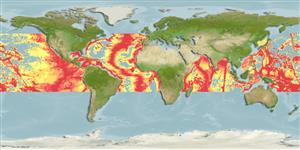Teleostei (teleosts) >
Aulopiformes (Grinners) >
Bathysauridae (Deepsea lizardfishes)
Etymology: Bathysaurus: Greek, bathys = deep + Greek, sauros = lizard (Ref. 45335).
More on author: Günther.
Environment: milieu / climate zone / depth range / distribution range
Ecology
Marine; bathydemersal; depth range 1550 - 4903 m (Ref. 58302), usually 2000 - ? m (Ref. 4472). Deep-water; 50°N - 20°S, 180°W - 180°E
Circumglobal between latitude 50°N-20°S except tropical eastern Pacific. Eastern Atlantic: northern Ireland; Morocco to Gabon.
Size / Weight / Age
Maturity: Lm ? range ? - ? cm
Max length : 78.0 cm SL male/unsexed; (Ref. 4472); common length : 40.0 cm SL male/unsexed; (Ref. 4472)
Dorsal soft rays (total): 16 - 17; Anal soft rays: 13; Vertebrae: 50 - 51. Moderately elongate and slender. Slightly depressed anteriorly and compressed posteriorly. Color generally white, with peritoneum, branchial and buccal regions dark. Small specimens have faint vertical bars (Ref. 37039).
Benthic (Ref. 58302). Found on the continental rise and the abyss, commonly below 2,000 m, in water colder than 4°C. Larvae are probably pelagic in near-surface midwaters. Solitary, lurking bottom feeder. Probably piscivore (Ref. 4964).
Life cycle and mating behavior
Maturities | Reproduction | Spawnings | Egg(s) | Fecundities | Larvae
Contrary to Ref. 240 this species is an hermaphrodite (Ref. 7463).
Sulak, K.J., 1990. Synodontidae. p. 365-370. In J.C. Quero, J.C. Hureau, C. Karrer, A. Post and L. Saldanha (eds.) Check-list of the fishes of the eastern tropical Atlantic (CLOFETA). JNICT, Lisbon; SEI, Paris; and UNESCO, Paris. Vol. 1. (Ref. 4472)
IUCN Red List Status (Ref. 130435)
Threat to humans
Harmless
Human uses
Tools
Special reports
Download XML
Internet sources
Estimates based on models
Preferred temperature (Ref.
123201): 1.7 - 4.1, mean 2.2 °C (based on 3164 cells).
Phylogenetic diversity index (Ref.
82804): PD
50 = 1.0000 [Uniqueness, from 0.5 = low to 2.0 = high].
Bayesian length-weight: a=0.00324 (0.00128 - 0.00816), b=3.16 (2.94 - 3.38), in cm total length, based on LWR estimates for this (Sub)family-body shape (Ref.
93245).
Trophic level (Ref.
69278): 4.5 ±0.80 se; based on food items.
Resilience (Ref.
120179): Low, minimum population doubling time 4.5 - 14 years (Assuming tmax>10).
Fishing Vulnerability (Ref.
59153): High vulnerability (58 of 100).
